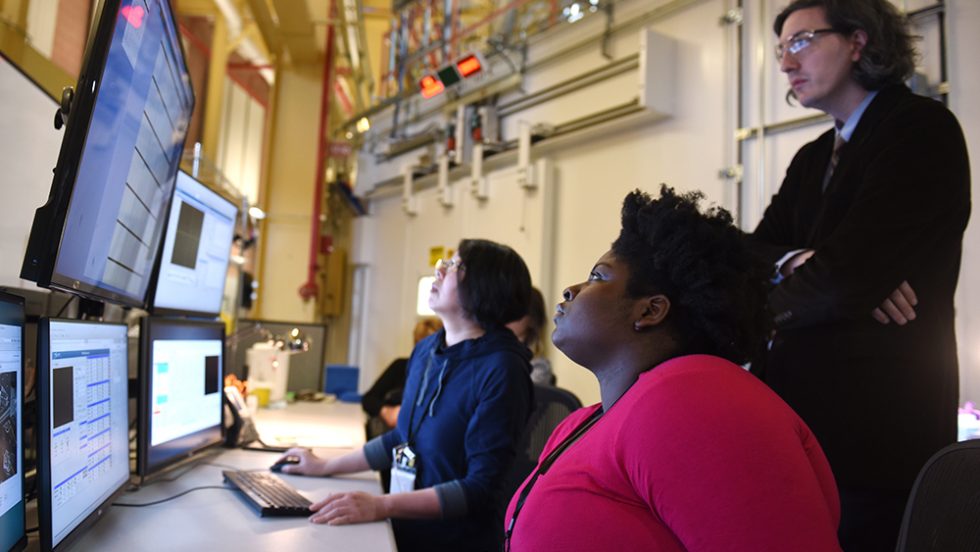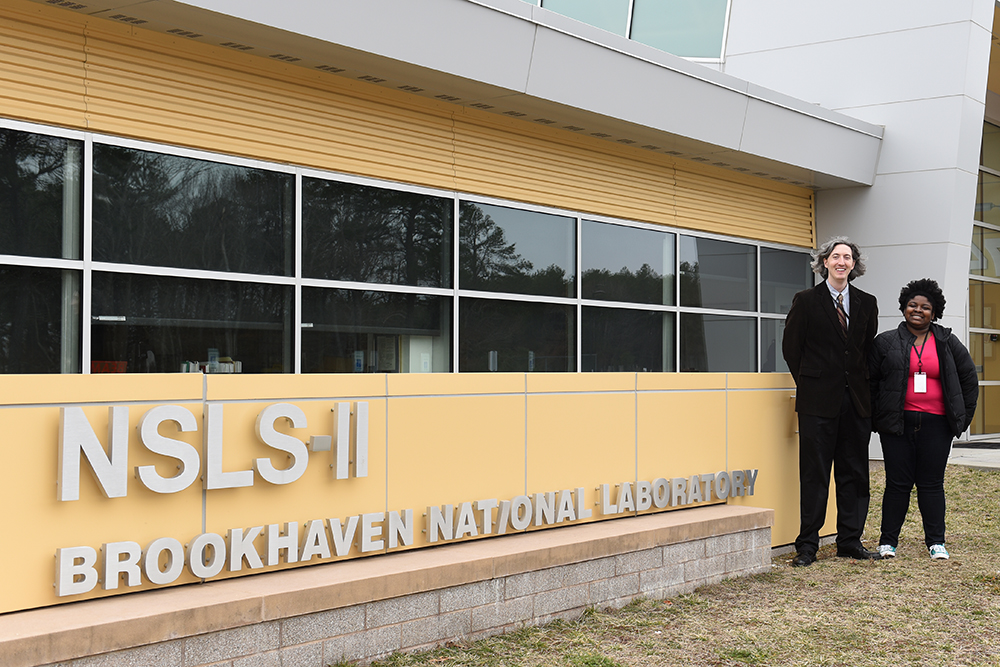
Assistant Professor Ivan Fabe Dempsey Hyatt, Ph.D., and Adelphi student Marly Medard, accompanied by her crystal sample, arrived to work on a beamline of the synchrotron.
“Curious, creative and persistent”—this is how Assistant Professor Ivan Fabe Dempsey Hyatt, PhD, described his student Marly Medard, a junior majoring in chemistry and a member of his undergraduate Hyatt Research Group. “She likes to do research and come up with different ways to solve problems,” Dr. Hyatt said. “And she doesn’t take no for an answer.”
These qualities paid off when Medard discovered a chemical reaction that resulted in an intriguing molecule sample. She then logged in hundreds of hours analyzing, purifying and growing a .3-millimeter crystal of the molecule.
Medard and Dr. Hyatt researched the crystal using Adelphi’s nuclear magnetic resonance (NMR) spectrometer. “We did just about every experiment we could with the NMR, and it gave us a great guess on what the molecular structure of the reaction is,” Dr. Hyatt said.
This kind of patience and persistence is part of succeeding in the sciences. But there’s nothing wrong with speeding up the process, something you can do if one of the world’s most renowned scientific facilities is practically on your doorstep.

Assistant Professor Ivan Fabe Dempsey Hyatt, PhD, and Adelphi student Marly Medard at Long Island’s Brookhaven National Laboratory.
Long Island’s Brookhaven National Laboratory (BNL) is 40 miles east of Adelphi. On a tour, Dr. Hyatt spoke with lab scientists who expressed interest in Medard’s crystal. When they offered him and his student access to a beamline on the lab’s National Synchrotron Light Source II (NSLS-II), he jumped at the opportunity.
According to NSLS-II director John Hill, the synchrotron is “a machine that produces very bright X-rays, a type of light that travels through materials and allows us to see what is happening inside those materials.” The NSLS-II “saw first light”—a rather poetic way of saying it started operations—in 2015.
“This is truly a rare opportunity for undergraduate students,” Dr. Hyatt said. “Scientists come from all over the country to get their samples analyzed at BNL. Due to the cost of travel and lodging, most professors only allow for selected graduate students or postdocs to come with them.”
On February 23, 2017, he and Medard, accompanied by her crystal sample, arrived to work on a beamline of the synchrotron to resolve the structure of the crystal’s molecules.They were joined by Martin R. Fuchs, Ph.D., lead beamline scientist, and Wuxian Shi, Ph.D., partner user scientist from Case Western University. Dr. Fuchs commented that such partnerships between the lab and visiting scientists from around the world are win-win situations, as the visitors can take data at a highly specialized machine, and the local scientists can learn from the measurements on new specimens.
“While most research at the FMX beamline at NSLS-II focuses on structural biology and investigating challenging crystallography problems, measuring a small molecule crystal like the one developed by this Adelphi student was the perfect opportunity to test the high-energy performance of this new beamline. We welcome the opportunity to collaborate with outside organizations and universities and to help educate our next generation of scientists,” said Dr. Fuchs.
Medard admitted that she was initially nervous about doing research at Brookhaven, saying, “It is place where groundbreaking research has been done and I wanted my work to be worthy of the lab.” But thanks to the help of the researchers, she said, “both skilled veterans, I had an amazing experience. Dr. Hyatt and I did a lot of preparation work before we left, but even as we were analyzing the crystals, we had to adjust to new problems. That was my favorite part. I learned that as a scientist, it isn’t wise to fear problems or obstacles, just solve them and move on.”
What exactly did the scientists learn about the crystal structure of Medard’s molecule? Here’s where that persistence comes into play again. Now professor and student will work to interpret the data. “The data set we collected looks excellent and I can’t wait to see what comes out of it,” said Dr. Hyatt. “Does our rough idea of the molecular structure we obtained from NMR hold up, or is something different?” Either way, he is confident Medard’s data will be published in a professional journal. Getting published is a goal he encourages all his students to attain.
Medard added, “I find my research really interesting and would love to meaningfully contribute to my lab and to the scientific community.”
Dr. Hyatt believes this is just the start of Adelphi’s partnership with Brookhaven National Lab. He plans to return with Medard so she can continue her research and to bring the other students from his Hyatt Research Group as well.